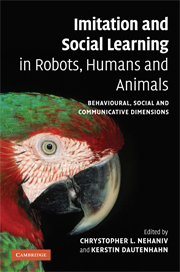 Imitation and Social Learning in Robots, Humans and Animals
Imitation and Social Learning in Robots, Humans and Animals Published online by Cambridge University Press: 10 December 2009
Introduction
Imitation is a powerful mechanism to culturally propagate and maintain knowledge and abilities. Not only humans rely heavily on imitation and social learning in general, but also animals such as dolphins, some bird species and some primates rely on imitation to acquire gestures and articulations (see e.g. Dautenhahn and Nehaniv, 2002b; Whiten and Ham, 1992). Studies on social learning in cognitive science have concentrated on mimicry, joint attention, the relationship between imitator and imitated, theory of mind, intentionality, speech (Kuhl and Meltzoff, 1996) and learning affordances of objects and tools (Tomasello, 1999). All these issues have been considered by artificial intelligence in constructing artefacts that learn from imitation, either in simulation (e.g. Alissandrakis et al., 2001) or on robotic platforms (e.g. Kuniyoshi et al., 1994; Gaussier et al., 1998; Billard and Hayes, 1997; Schaal, 1999). In this chapter however we wish to pay attention to the role of the social medium in which imitation takes place. Often, imitation is considered to take place only between two agents: one acts as teacher and the other as student. The teacher is in possession of a full repertoire of gestures, actions or articulations, which the student has to acquire through imitation learning. This is of course a valid approach when one is interested in the paradigm of imitation to program artefacts by demonstration (Bakker and Kuniyoshi, 1996).
To save this book to your Kindle, first ensure [email protected] is added to your Approved Personal Document E-mail List under your Personal Document Settings on the Manage Your Content and Devices page of your Amazon account. Then enter the ‘name’ part of your Kindle email address below. Find out more about saving to your Kindle.
Note you can select to save to either the @free.kindle.com or @kindle.com variations. ‘@free.kindle.com’ emails are free but can only be saved to your device when it is connected to wi-fi. ‘@kindle.com’ emails can be delivered even when you are not connected to wi-fi, but note that service fees apply.
Find out more about the Kindle Personal Document Service.
To save content items to your account, please confirm that you agree to abide by our usage policies. If this is the first time you use this feature, you will be asked to authorise Cambridge Core to connect with your account. Find out more about saving content to Dropbox.
To save content items to your account, please confirm that you agree to abide by our usage policies. If this is the first time you use this feature, you will be asked to authorise Cambridge Core to connect with your account. Find out more about saving content to Google Drive.